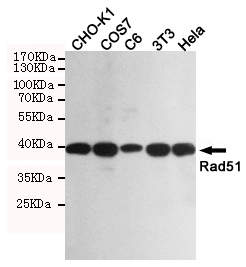Rad51 Antibody
Purified Mouse Monoclonal Antibody (Mab)
- 产品详情
- 实验流程
- 背景知识
Application
| WB |
|---|---|
| Primary Accession | Q06609 |
| Reactivity | Human, Mouse |
| Host | Mouse |
| Clonality | Monoclonal |
| Isotype | IgG2a |
| Calculated MW | 36966 Da |
| Gene ID | 5888 |
|---|---|
| Other Names | BRCA1/BRCA2 containing complex, subunit 5 ; BRCC 5 ; BRCC5 ; DNA repair protein RAD51 homolog 1 ; DNA repair protein rhp51 ; HRAD51 ; HsRad51 ; HsT16930 ; MRMV2 ; Rad 51 ; RAD51 ; RAD51 homolog (RecA homolog, E. coli) (S. cerevisiae) ; RAD51 homolog A ; RAD51 homolog ; RAD51 recombinase ; RAD51, S. cerevisiae, homolog of ; RAD51_HUMAN ; RAD51A ; RECA ; RecA like protein ; RecA, E. coli, homolog of ; Recombination protein A. |
| Dilution | WB~~1:1000 |
| Format | Liquid in PBS containing 50% glycerol, 0.5% BSA and 0.02% sodium azide, pH 7.3. |
| Storage | Store at 4°C short term. Aliquot and store at -20°C long term. Avoid freeze/thaw cycles. |
| Name | RAD51 (HGNC:9817) |
|---|---|
| Synonyms | RAD51A, RECA |
| Function | Plays an important role in homologous strand exchange, a key step in DNA repair through homologous recombination (HR) (PubMed:12205100, PubMed:18417535, PubMed:20231364, PubMed:20348101, PubMed:22325354, PubMed:23509288, PubMed:23754376, PubMed:26681308, PubMed:28575658, PubMed:32640219). Binds to single-stranded DNA in an ATP-dependent manner to form nucleoprotein filaments which are essential for the homology search and strand exchange (PubMed:12205100, PubMed:18417535, PubMed:20231364, PubMed:20348101, PubMed:23509288, PubMed:23754376, PubMed:26681308, PubMed:28575658). Catalyzes the recognition of homology and strand exchange between homologous DNA partners to form a joint molecule between a processed DNA break and the repair template (PubMed:12205100, PubMed:18417535, PubMed:20231364, PubMed:20348101, PubMed:23509288, PubMed:23754376, PubMed:26681308, PubMed:28575658, PubMed:38459011). Recruited to resolve stalled replication forks during replication stress (PubMed:27797818, PubMed:31844045). Part of a PALB2-scaffolded HR complex containing BRCA2 and RAD51C and which is thought to play a role in DNA repair by HR (PubMed:12442171, PubMed:24141787). Plays a role in regulating mitochondrial DNA copy number under conditions of oxidative stress in the presence of RAD51C and XRCC3 (PubMed:20413593). Also involved in interstrand cross-link repair (PubMed:26253028). |
| Cellular Location | Nucleus. Cytoplasm. Cytoplasm, perinuclear region. Mitochondrion matrix Chromosome. Cytoplasm, cytoskeleton, microtubule organizing center, centrosome Note=Colocalizes with RAD51AP1 and RPA2 to multiple nuclear foci upon induction of DNA damage (PubMed:20154705). DNA damage induces an increase in nuclear levels (PubMed:20154705). Together with FIGNL1, redistributed in discrete nuclear DNA damage-induced foci after ionizing radiation (IR) or camptothecin (CPT) treatment (PubMed:23754376). Accumulated at sites of DNA damage in a SPIDR- dependent manner (PubMed:23509288). Recruited at sites of DNA damage in a MCM9-MCM8-dependent manner (PubMed:23401855). Recruited at sites of DNA damage following interaction with TOPBP1 in S-phase (PubMed:26811421). Colocalizes with ERCC5/XPG to nuclear foci in S phase (PubMed:26833090). Recruited to stalled replication forks during replication stress by the TONSL-MMS22L complex, as well as ATAD5 and WDR48 in an ATR-dependent manner (PubMed:27797818, PubMed:31844045) |
| Tissue Location | Highly expressed in testis and thymus, followed by small intestine, placenta, colon, pancreas and ovary. Weakly expressed in breast |
For Research Use Only. Not For Use In Diagnostic Procedures.
Provided below are standard protocols that you may find useful for product applications.
BACKGROUND
Participates in a common DNA damage response pathway associated with the activation of homologous recombination and double-strand break repair. Binds to single and double-stranded DNA and exhibits DNA-dependent ATPase activity. Underwinds duplex DNA and forms helical nucleoprotein filaments. Part of a PALB2- scaffolded HR complex containing BRCA2 and RAD51C and which is thought to play a role in DNA repair by HR. Plays a role in regulating mitochondrial DNA copy number under conditions of oxidative stress in the presence of RAD51C and XRCC3.
REFERENCES
Shinohara A.,et al.Nat. Genet. 4:239-243(1993).
Yoshimura Y.,et al.Nucleic Acids Res. 21:1665-1665(1993).
Schmutte C.,et al.Cancer Res. 59:4564-4569(1999).
Wang W.W.,et al.Cancer Epidemiol. Biomarkers Prev. 10:955-960(2001).
Park J.Y.,et al.Nucleic Acids Res. 36:3226-3234(2008).
终于等到您。ABCEPTA(百远生物)抗体产品。
点击下方“我要评价 ”按钮提交您的反馈信息,您的反馈和评价是我们最宝贵的财富之一,
我们将在1-3个工作日内处理您的反馈信息。
如有疑问,联系:0512-88856768 tech-china@abcepta.com.























 癌症的基本特征包括细胞增殖、血管生成、迁移、凋亡逃避机制和细胞永生等。找到癌症发生过程中这些通路的关键标记物和对应的抗体用于检测至关重要。
癌症的基本特征包括细胞增殖、血管生成、迁移、凋亡逃避机制和细胞永生等。找到癌症发生过程中这些通路的关键标记物和对应的抗体用于检测至关重要。 为您推荐一个泛素化位点预测神器——泛素化分析工具,可以为您的蛋白的泛素化位点作出预测和评分。
为您推荐一个泛素化位点预测神器——泛素化分析工具,可以为您的蛋白的泛素化位点作出预测和评分。 细胞自噬受体图形绘图工具为你的蛋白的细胞受体结合位点作出预测和评分,识别结合到自噬通路中的蛋白是非常重要的,便于让我们理解自噬在正常生理、病理过程中的作用,如发育、细胞分化、神经退化性疾病、压力条件下、感染和癌症。
细胞自噬受体图形绘图工具为你的蛋白的细胞受体结合位点作出预测和评分,识别结合到自噬通路中的蛋白是非常重要的,便于让我们理解自噬在正常生理、病理过程中的作用,如发育、细胞分化、神经退化性疾病、压力条件下、感染和癌症。






